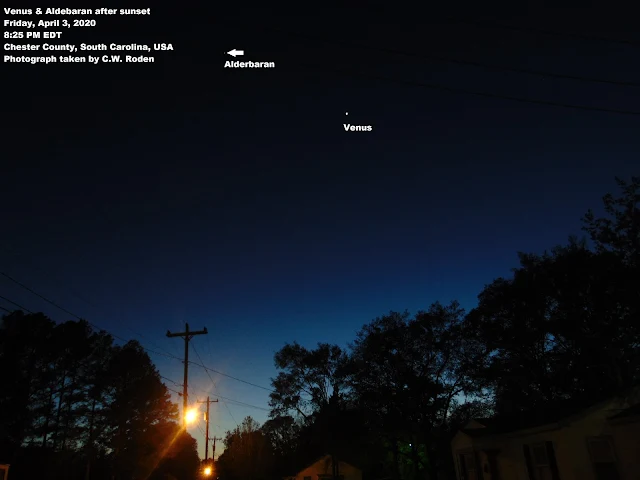Good evening fellow stargazers!
Well, I am happy to report that the skies above my corner of South Carolina were wonderfully clear these last few nights giving me a clear view of the close conjunction between bright Venus and the faint Pleiades Star Cluster (also known as the Seven Sisters).
Although the planet Venus actually has a conjunction with the Pleiades star cluster every year, the closest of these conjunctions only come in early April and recur in cycles of 8 years, or every other leap year.
This year I am pleased to say that I was able to take photos of Venus transitioning into the close conjunction with and then away from the Pleiades in the western sky after sunset over a period of three days.
The first set of photos show Venus just below the Pleiades traveling eastward and moving towards conjunction on Thursday, April 2nd.
The first set of photos show Venus just below the Pleiades traveling eastward and moving towards conjunction on Thursday, April 2nd.
The second set of photos shows Venus among the Seven Sisters in their close conjunction on Friday, April 3rd.
The third set of photos show Venus now above the star cluster moving away and continuing to rise further in the evening sky.
Despite being nicknamed the "Seven Sisters" as you can see in the photos where I labeled the major stars of the cluster, that there are in fact nine named stars. The nine brightest stars of the Pleiades are named for the Seven Sisters of Greek mythology: Sterope, Merope, Electra, Maia, Taygeta, Celaeno, and Alcyone, along with their parents Atlas and Pleione. All of them are hot Type B Stars which shine far brighter than our own sun, but at an estimated distance of 390 to 460 light-years distant they seem very small to the naked eye.
The Pleiades cluster is visible from virtually every part of the globe. It can be seen from as far north as the North Pole, and farther south than the southernmost tip of South America. It looks like a tiny misty dipper of stars and is just visible to the naked eye.
My next photo is a background shot of Venus and Alderbaran about 45 minutes, or so, after sunset during the conjunction of Friday, April 3rd.
The best way to spot the Pleiades is to look for the bright star Aldebaran in the constellation Taurus the Bull. The Pleiades can be spotted near Aldebaran. The star name Aldebaran comes from an Arabic word for follower and thought to be a reference to this star forever chasing the Pleiades across the heavens. The reddish star is sometimes referred to as the "Eye of the Bull". In the Northern Hemisphere, the Pleiades rise before Aldebaran in the east and sets before the Bull's fiery-red eye in the west.
In addition to the conjunction and Venus' journey towards and away from the Seven Sisters, towards the eastern sky I was able to capture a pair of really great shots of the waxing gibbous moon just before sunset and then after sunset a shot of Luna with the bright star Regulus just to the right.
Well folks, once again I hope y'all enjoyed my night sky offerings for this evening. Have a wonderful Dixie day and be sure to keep your eyes to the night skies, y'all!









No comments:
Post a Comment
Please Let Me Know What Y'all Think In The Comments Section.
All comments are moderated and can take up to 12 hours to be posted.
No blasphemy or anti-religious comments against anyone's faith are permitted on this site.